
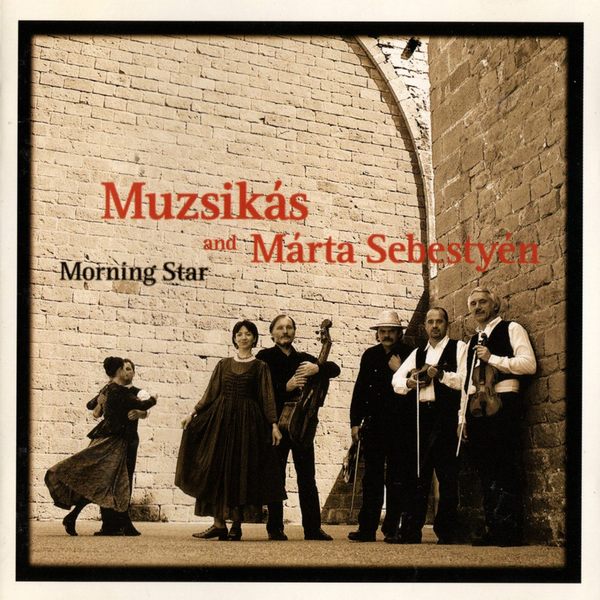 |
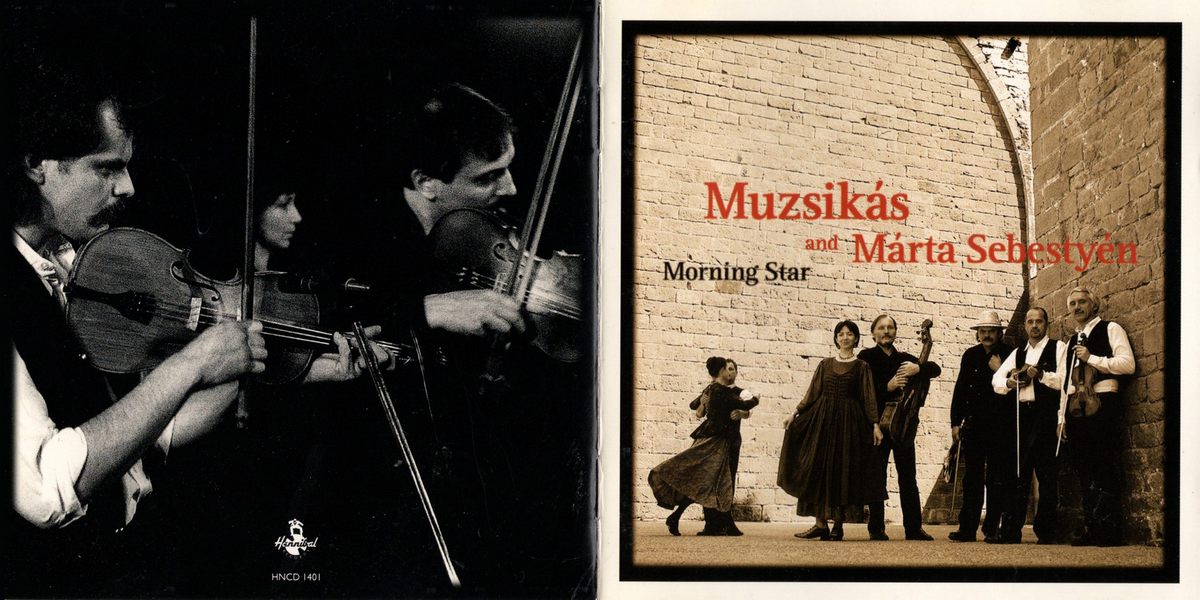
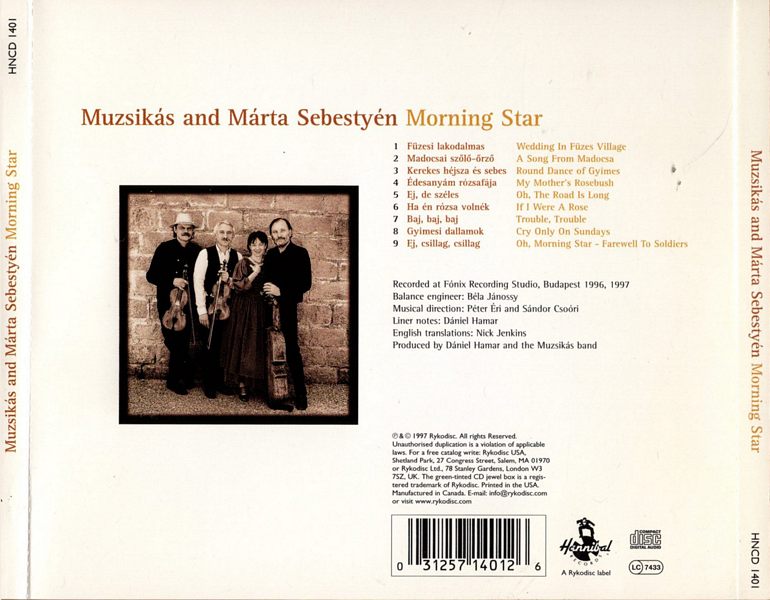
|
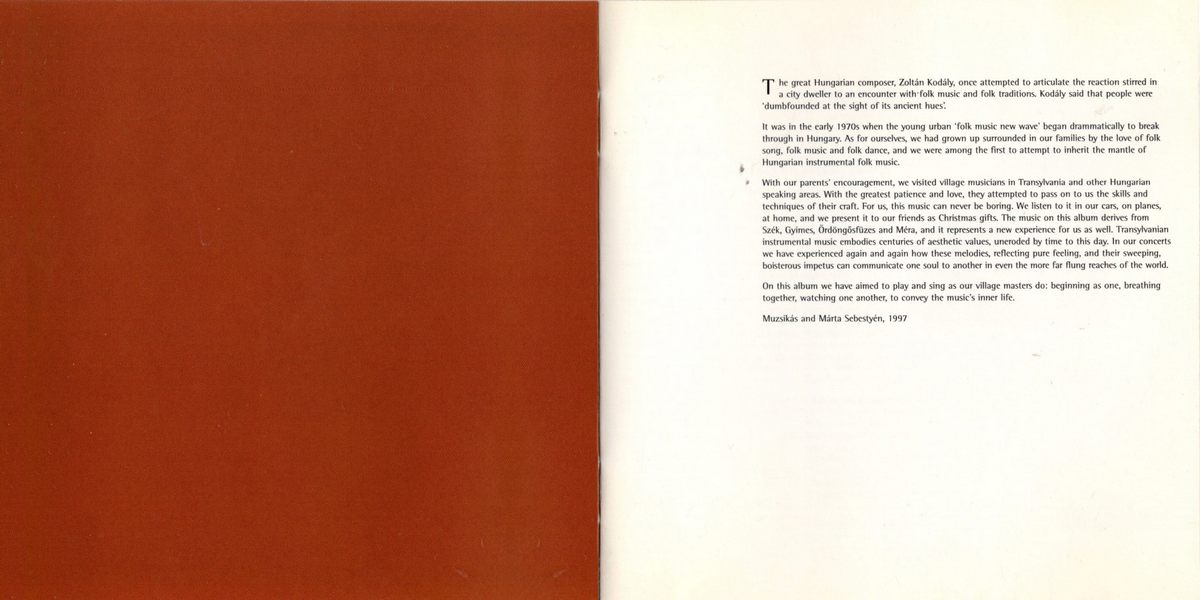
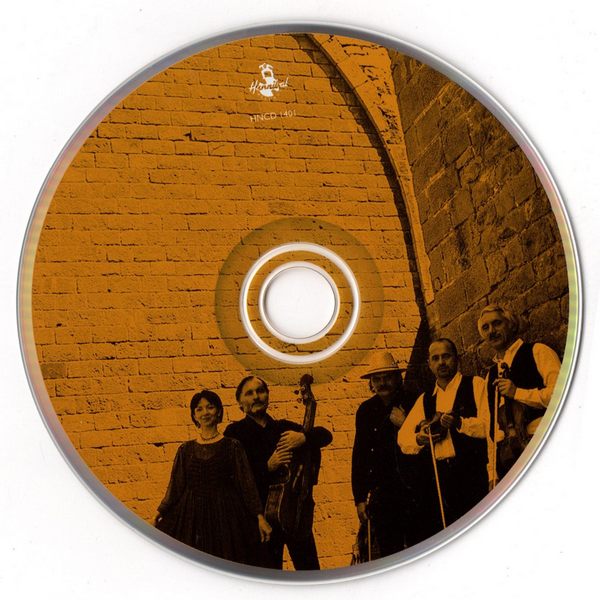 |
Sleeve Notes
The great Hungarian composer, Zoltán Kodály, once attempted to articulate the reaction stirred in a city dweller to an encounter with folk music and folk traditions. Kodály said that people were 'dumbfounded at the sight of its ancient hues'.
It was in the early 1970s when the young urban 'folk music new wave' began dramatically to break through in Hungary. As for ourselves, we had grown up surrounded in our families by the love of folk song, folk music and folk dance, and we were among the first to attempt to inherit the mantle of Hungarian instrumental folk music.
With our parents' encouragement, we visited village musicians in Transylvania and other Hungarian speaking areas. With the greatest patience and love, they attempted to pass on to us the skills and techniques of their craft. For us, this music can never be boring. We listen to it in our cars, on planes, at home, and we present it to our friends as Christmas gifts. The music on this album derives from Szék, Gyimes, Ördöngősfüzes and Méra, and it represents a new experience for us as well. Transylvanian instrumental music embodies centuries of aesthetic values, uneroded by time to this day. In our concerts we have experienced again and again how these melodies, reflecting pure feeling, and their sweeping, boisterous impetus can communicate one soul to another in even the more far flung reaches of the world.
On this album we have aimed to play and sing as our village masters do: beginning as one, breathing together, watching one another, to convey the music's inner life.
Muzsikás and Marta Sebestyén, 1997
Füzesi lakodalmas (Wedding In Füzes Village) — These are traditional wedding melodies from the village Ördöngősfüzes (Füzes) in the Mezőség region of Transylvania. Mezőség is one of the richest territories of the folk tradition in Europe. The population is an ethnic mix of Rumanians, Hungarians, Transylvanian Saxons and Gypsies. In the course of history these people (nations) have developed together, through close mutual influences, a folk culture of extraordinary wealth. This richness could never have emerged, or at least not in such variegated form, had there been only one single culture present. The melodies played here start with a male dance (verbunk), followed by a wedding song. Later there is female singing, together with rhythmical shouting, known as csujogatás, and at the end a faster couple dance is played. These melodies are typical of wedding parties, but are usually much longer and combine with several other melodies to make an unforgettable wedding party lasting two days and two nights.
Madocsai szőlő-őrző (A Song From Madocsa) — Madocsa is a village in the region of Sárköz, about 120 km South of Budapest, famous for its vineyards. The first melody, sung by Márta, comes from an old tradition called 'grape-guarding', whereby a few days before the harvest all the engaged couples would move to the vineyards and spend the days and nights playing games, dancing and singing. Márta's vocal presentation is followed by the same melody played by fiddle and kis-cimbalom (similar to the hammer dulcimer) as slow and fast csárdás.
Kerekes héjsza és sebes (Round Dance of Gyimes) — Gyimes is a region in the Eastern Carpatian Mountains. The Hungarians who live there are called csángós and they have a special band with only two instruments: the fiddler and the gardon player. The gardon is a cello-shaped percussion instrument with three thicker gut-strings and one thinner, all tuned to the same tone (usually 'D'). The three thicker strings are hit with a wooden stick while the thinner one is picked and used to slap the fingerboard. The rhythm is given by these two effects. This accompaniment and the archaic style of the violin give Gyimes music its unique character. We learnt these melodies from Mihály Halmágyi and his wife, Gizella Adám, extraordinary musicians of the village Gyimesközéplok. The first melody is for a round dance called kerekes héjsza and is followed by a melody for a couple dance called sebes magyaros. The male dancer sometimes dances out complicated rhythms on the wooden floor as his mood increases. Our dancer-choreographer Zoltáan Farkas did this for us in the sound recording studio.
Édesanyám rózsafája (My Mother's Rosebush) — In Transylvania on any dancing ocassion (especially at wedding parties or in dance houses) the musicians used to play a certain set of music for the continuous dance. It consisted of several melodies for different dances and sometimes it took more than an hour. Then they would have a break and start the next dance-cycle. During the interval those who wanted to sing would go to the musicians and order the melody from them. This song is one of those which were sung on such occasions and has one of the most beautiful melodies of them all. It is from the village Méra (Kalotaszeg, Transylvania). They used to sing this melody with several different verses, sometimes as a farewell song to the bride at a wedding party. We have chosen the love-song verses.
Ej, de széles (Oh, The Road Is Long) — This is another traditional piece from the village Ördöngősfüzes (Füzes). We often travel to this region, to listen to the musicians, make field recordings and learn the style of the Füzes band. The traditional band consists of two fiddlers, a kontra and a contrabass. The violin is played without a chin-rest. The kontra is a special instrument that is widespread in Transylvania. It is made in the style of a violin or viola with only three strings, strung over a straight bridge so that they are all level in sound chords and triads. The bass has two or three gut strings but one (the thickest) is played with a short bow. This piece starts with a melody of an old man's dance followed by a slow csárdás melody which can be played to accompany a dance or a singer.
Ha én rózsa volnék (If I Were A Rose) — This piece is an arrangement of a Hungarian folk song and a Bashkirian folk song. The Hungarian song belongs to the most popular group of ancient Hungarian folk melodies. The melody can be found in several different versions throughout the different Hungarian cultural territories and it displays a close affinity to some oriental melodies. Similar melodies have been found among oriental ethnic groups, people who lived as neighbours of the Hungarian tribes more than a thousand years ago. The similarity of the Hungarian and the Bashkirian melodies was discovered by Péter Éri.
Baj, baj, baj (Trouble, Trouble) — This is the third set of melodies from the village Füzes on this album. Even though there are several other traditional bands in Mezőség, we found it important to arrange a third piece based on the field recordings in Füzes. This band plays an extraordinary ancient style. Nowadays many bands follow the fashion of the 'modern ages' and try to play the commercial melodies they can hear on the 'music channels'. Bands like the one from Füzes who play only in the 'old style' are invited less to perform on the radio. This piece starts with the melodies of a virtuoso lads' dance ani continues with a song which is a melody for a couple dance.
Gyimesi dallamok (Cry Only On Sundays) — The melodies of this piece are from Gyimes, like the Round Dance. The first melody is an asymmetrical couple dance played first by the fiddle in a free form. Slowly it becomes more rhythmical and the gardon joins. Some of these lassü magyaros dance melodies have words and some have only instrumental versions. The next melody is a verbunk, which in this instance is a virtouso dance for a man. The piece ends with the 'Rákóczi March', played by three fiddles and two gardons. In Gyimes if more than two musicians played, they doubled the usual instruments (violin and gardon) rather than apply other instruments. They never danced to the music of the 'Rákóczi March', but in wedding parties it was played in certain events. The usual dance occasions used to end with this melody, so they know different versions of the Rákóczi March' through the Hungarian cultural territories. The French composer Berlioz has written a symphonic piece using one version of this melody.
Ej, csillag, csillag (Oh, Morning Star — Farewell To Soldiers) — This is a song from the village Méra in Transylvania, Rumania. It is one of the Kalotaszeg villages where the people have kept their traditions alive. The population of the village is almost entirely Hungarian. There are a few gypsy families and these are the musicians of the village. This song was played to us by one of the best 'primas' (fiddlers) of the village, Sandor Fodor ('Neti') and the song was sung by Márton Kata Ambrusné, one of the best singers in the village. Not so long ago all 18-year-old boys had to do military service for at least three years. All of the boys of the village were sent to different military locations, usually far from home. During this century these locations were in Rumanian speaking territories, so the Hungarian boys would have additional difficulties as they were different from the others. After the service they would become a 'fully fledged man' of the village, and they would be able to marry. The recruits would spend the last night together before going to the meeting point. Their lovers and families would be with them. They danced and sang all night, waiting for the rising of the 'morning star', the sign that they had to go. This song refers to this tradition and speaks of the atmosphere of the last night.